22 July 2014
Sealed orders – The part the Fianna played at Howth
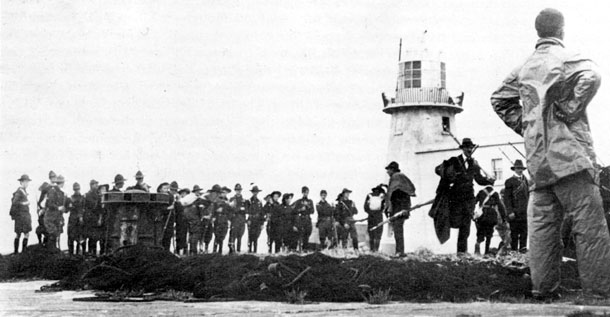
• Members of Fianna await orders on Howth Pier
By Corporal ‘Willie Nelson’ [Pádraig Ó Riain*]. From Nodlaig na bhFiann, December 1914.
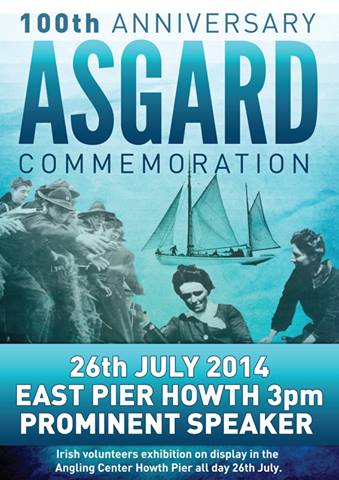 I WAS
AWAKENED by a loud knocking at the hall door. I awoke slowly and wondered who
the disturber of the Sabbath morn was. I yawned, stretched myself and finally
looked at the clock. It was five minutes to seven.
I WAS
AWAKENED by a loud knocking at the hall door. I awoke slowly and wondered who
the disturber of the Sabbath morn was. I yawned, stretched myself and finally
looked at the clock. It was five minutes to seven.
I then began debating with myself (for, being a member of the Sluagh committee, I have an aptitude for debate) as to whether the disturber was the post, a seller of the Sunday Freeman, or an early-rising milkman.
I pride myself for having a logical mind, a gift which Madame [Markievicz] was the first person to discover I possessed. I reasoned like this. It cannot be the post for he only gives two short raps and departs; neither can it be a milkman, for every sane milkman supplements his knocking by melodiously rattling his can on the kerb. I was about to turn over and leave the honour with the seller of newspapers when the knocking grew louder and more persistent. Curiosity impelled me to get up and, on looking out of the window, to my astonishment, I saw my leader, Paddy Holohan, renewing his attacks on the knocker with great vigour.
“Hello, Paddy,” said I. “What’s the row about?”
“You lazy beggar!” he shouted back. “I have been knocking here for the last half-hour and I might as well have been knocking at the morgue for all the notice was taken of it.”
Then, in sterner tones, he commanded:
“You are to parade in the Hardwicke Street Hall at half-past nine, and bring rations for a day’s march with you.”
And, muttering something about sealed orders from the Military Council, he bolted off.
***
When I arrived in Hardwicke Street, I found nearly all the older members of the Sluagh present; also members from An Cheud Sluagh and the Sluagh in Inchicore. They were all speculating about the march. Some argued that we were going to Lucan to start a new Sluagh, whilst others asserted we were going on a day’s manoeuvres with the Volunteers. This view was generally accepted when we subsequently joined the Volunteers at Fairview.
Pádraig Ó Riain, who was in command of the Fianna, in a few words gave us to understand that strict discipline was to be maintained throughout the day. Seán Heuston had charge the transport section. The trek-cart was heavily loaded and closely covered. I was in this section and understood Seán to say that the cart contained minerals and refreshments for the Volunteers.
We were allotted a position in the centre of the column, where we held until we were very near Howth, where we proceeded to the head of the column. We entered the village at the head of the Volunteers and halted at the pier near the foot of the hill.
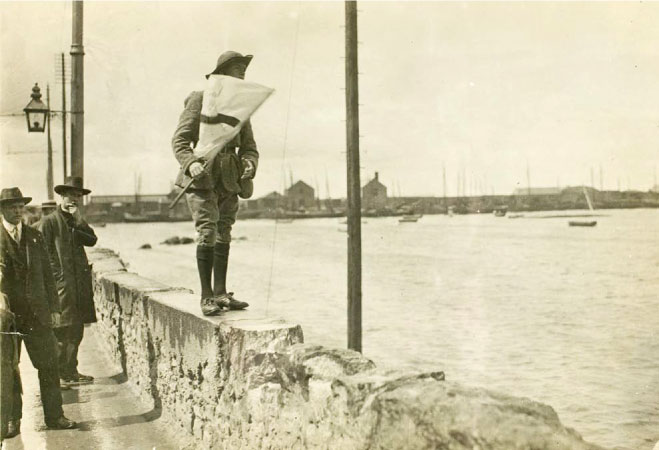
• A Fianna signaller awaiting the Asgard
***
We went up the pier at the double and outran the Volunteers. Some men were already unloading a yacht. The Fianna were ordered to assist.
Our section, under Seán Heuston, at once unpacked the trek-cart, which disgorged not minerals or sandwiches but large wooden batons. These were rushed down and distributed to the companies which blocked the entrance to the pier. The object of our march was now obvious – rifles had at last arrived.
The coastguards sent up rockets for help and the Volunteers sent up great triumphant cheers which re-echoed from the Hill of Howth to Dublin Castle and soured the champagne of the Kildare Street Club.
***
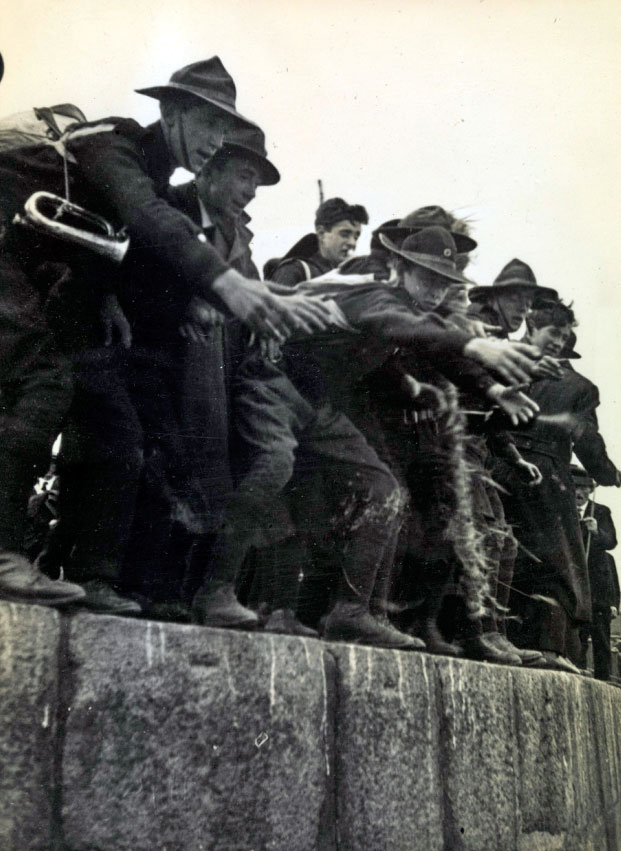
When I returned to the top of the pier, the Volunteers and Fianna were feverishly unpacking the rifles. There was an intense and silent activity. We quickly loaded our trek-cart with rifles and transferred them to the companies of the other end of the pier. I was engaged in this work until all the Volunteers were supplied.
The Volunteers and Fianna now carried rifles on their shoulders. Ammunition and rifles were also packed in our trek-cart and the remainder were dispatched in motor cars. We were ready to depart and awaited orders.
The long lines of armed men stretching the whole length of the pier was the most entrancing sight I have ever witnessed. We were filled with great joy and our souls were thrilled with the spirit of freedom.
As we left the pier, the people of Howth came out in great crowds to greet us. A priest from top of a tram blessed the rifles as we passed and we cheered response to his benediction.
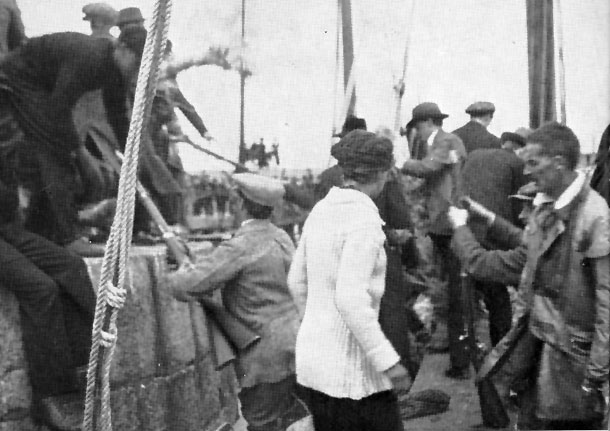
***
I was beginning to feel tired as we neared Dublin. The long march to Howth and back, the pulling of our heavily-laden trek-cart, the running and exertion on the pier now began to tell against me. But the thought of a triumphal march through the streets of Dublin with a rifle on my shoulder buoyed me up and made me feel extremely happy.
I had not taken Dublin Castle into consideration and did not believe our friendly Government would permit her to play her last stroke in as villainous a manner as events afterwards proved.
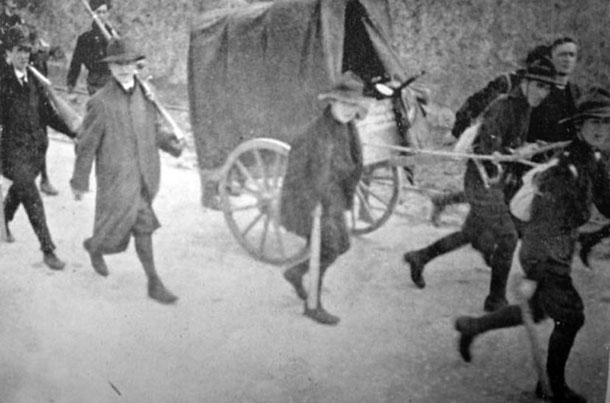
***
On the Howth Road, a few hundred yards from Clontarf, I saw a company of soldiers with fixed bayonets blocking our way to the city. As if to avoid the military, we turned to our right along Charlemont Road and on to the Malahide Road.
Before we were a hundred yards on the Malahide Road we knew that the first companies of Volunteers were in conflict with the military. The sounds of rifles clashing, revolver shots and shouting made a terrific din.
We got the order to “Halt!” and were told we had got to defend the ammunition at all costs.
The Captain of Ceud Sluagh drew an automatic pistol and, with some of our fellows, dashed off to join in the fray. It was with difficulty Seán Heuston and Pádraig Ó Riain restrained others.
We clustered around the cart with our rifles gripped tightly in our hands. Suddenly we saw the Volunteers scatter and run. Some of the men were bleeding from the head but most of them seemed uninjured and still clung to their rifles. As they passed us we appealed to them to stand. We shouted and called them cowards. Our commander, not knowing that they had received orders to retire and get off with their rifles, shouted: “By God! We won’t. run away.”
***
 Before
I had time to realise what had happened, the road in front of us was almost
clear and I saw the police with batons and rifles rushing in upon us. Then Pádraig
rushed out in front and shouted to us to come on. His voice was harsh and he
shouted and cursed most horribly.
Before
I had time to realise what had happened, the road in front of us was almost
clear and I saw the police with batons and rifles rushing in upon us. Then Pádraig
rushed out in front and shouted to us to come on. His voice was harsh and he
shouted and cursed most horribly.
We dashed out to meet the police.
I was near Paddy Holohan and O’Connor. They, too, were cursing and shouting defiantly. Everything was confusion. I saw the police and the soldiers and the glitter of their bayonets as in a maze. A huge policeman with a rifle swooped towards me. I was seized with a sort of frenzy and, putting forth all my strength, I made a deadly blow at his head.
I think my last ounce of strength went into that blow for I do not remember what happened after till I heard Seán Heuston calling me to lend a hand to pull the trek-cart. I distinctly remember his shrill voice when he gave the order. “Take strain – quick march!”
***
We were now retreating back along the Malahide Road. Joe Robinson was clinging to the back of the trek-cart in which the ammunition and rifles were still safely packed. There were only ten or twelve of us. Eamon Martin, Garry Holohan and some others were left behind. They were enjoying the sport too much to leave till all was over.
We wheeled to our left off the main road and were soon clear of immediate danger. We passed a couple of old men chatting near a pump. They seemed to be enjoying the summer’s evening and apparently knew nothing of the bloody episodes that were being enacted only a mile away.
We turned up a country lane near a big house and concealed ourselves in a bit of a wood on our right. It was now dusk so we decided to make a pretence of camping out and to conceal the rifles and ammunition until we could have them safely removed after dark. Our commander went up to the house and got permission to camp near the wood.
We buried the treasure, which was removed after dark in a taxi, and is now safe.
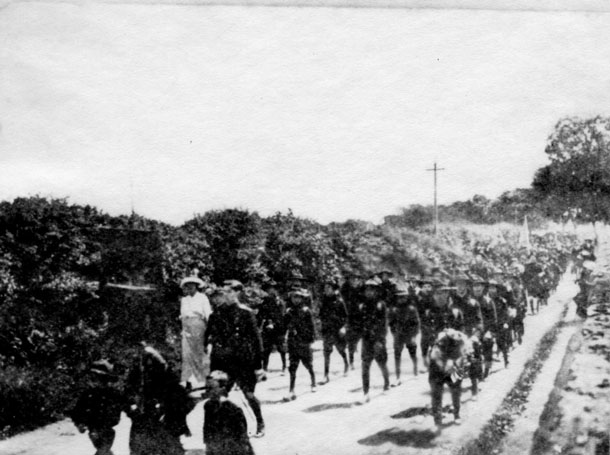
• The Fianna marching to Bodenstown 1912 or 1913. Pádraig Ó Riain leading Countess Markievicz on his right
*Pádraig Ó Riain was a member of the Irish Republican Brotherhood and, according to Bulmer Hobson:
“From the foundation of the Fianna in 1909 to the Rising of 1916, he was the dominating personality in the Fianna. He had a natural capacity for leadership and did an enormous amount of work.”
Ó Riain’s father was caretaker of the Irish National Foresters’ Hall, 41 Parnell Square, Dublin, and the secret drilling of the IRB took place there before the formation of the Irish Volunteers in November 1913. Ó Riain went North in 1916 to help the rising in County Tyrone. When the Rising misfired he went on to Belfast and lived there until his death.
Ó Riain contributed the weekly notes on the Fianna to The Irish Volunteer and to the Nodlaig na bhFiann, the organ of the Fianna, under the nom-de-plume of ‘Willie Nelson’.
For another account of the part played by the Fianna at Howth, see Gearoid Ó hUallacháin, ‘Teacht na nArm go Beann Eadair i 1914,’ in An Gaedheal, i Meithearnh 1935, p2.
Follow us on Facebook
An Phoblacht on Twitter
Uncomfortable Conversations

An initiative for dialogue
for reconciliation
— — — — — — —
Contributions from key figures in the churches, academia and wider civic society as well as senior republican figures




